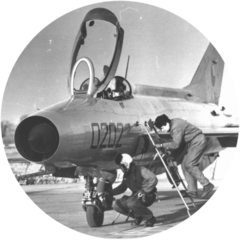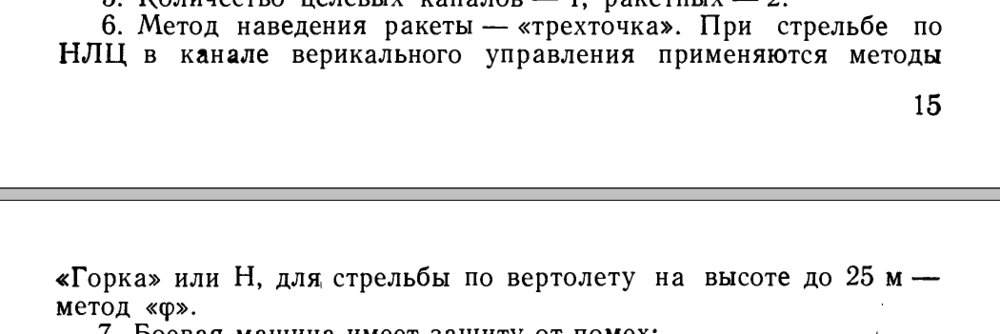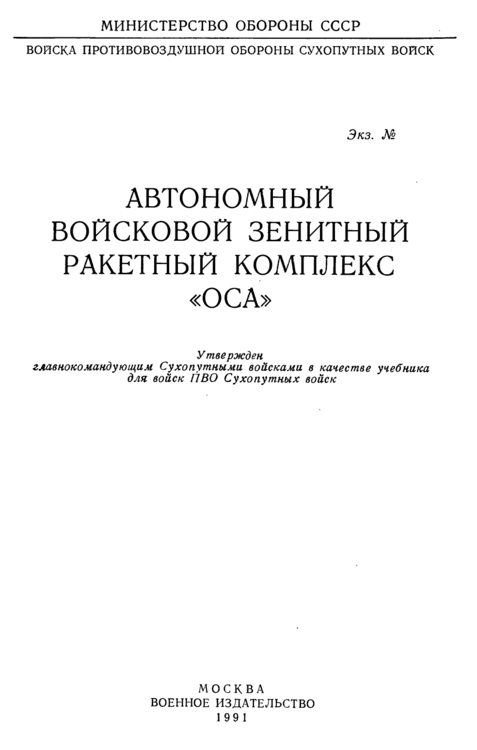-
Posts
168 -
Joined
-
Last visited
Content Type
Profiles
Forums
Events
Everything posted by Koty
-
Yes, there are other models with mistakes and or technical problems too (looking at the R-3S/R models still missing proper roughmets). Hopefully it gets a looked at.
-
I've realised this could probably be moved to https://forum.dcs.world/forum/423-ai-bugs-non-combined-arms/ or somewhere more appropriate.
-
R-60M model in DCS is in fact an R-60MK with its prominent Kolibri fuse on the side: R-60M uses an optical fuse, arranged with cruciform arrangement:
-

MiG-19 FM Dynamic stability comparison to MiG-15 and F-86
Koty replied to HWasp's topic in MiG-19 Farmer B
Keep in mind the 19P has an extended nose with a radar in it compared to the original day-light fighter. This brought a notable change in stability. -
If you want to be pedantic, it really is just the loss of lift. = loss of lift. You will usually start losing control before the wing is fully stalled. Some wings are designed in a way that allows part of the wing to stall earlier to warn you of incomming stall before your controls get into the stall-disturbed air as your wingtips inevitably stall. A really good example of this can be found with the Yak-28: the wing has a constant chord on the part outboard of the engines, between the engine and fuselage the chord lenghtens, decreasing the relative thickness and increasing leading edge sweep. The leading edge in front of the ailerons also has an extension which curves down (similar method was used on Convair deltas, however there it was primarily to reduce drag). This ensures you will feel the onset of stall long before your ailerons are stalled, retaining control. EDIT: On a side note, this reminds me how much I'd love to see the Yak in DCS
-
This is a good point, 3 point tracking alone will prevent people from just driving the missile into the ground. Would be even better with the other modes available, however the manual was not specific on how they function, so at best we can make assumptions that Gorka is some sort of lofted guidance and H is for constant altitude (H missile = H target). But this is just an educated guess.
-
From what I've heard and read so far, the limiting factors are available terminal manoeuvre G's, missile speed needs to be higher than launching platform speed at time of impact, overtake speed over target (important for rear aspect shots) should also be enough for the fuse to work properly. These limits will also probably differ depending on missile, launching platform and intended target
-
One major factor in launching missiles is seeker sensitivity. This was a limiting factor for the 7F which could barely see past 20 nm. New seeker on 7M is not just more sensitive and can pick up targets from much higher distances, it also does not (itself) need to see the target. This would imply lock on after launch capability, but you still require STT lock for the missile to go in the right direction.
-
There might be other systems with this problem, but no, this is very individual. But it might be worth having a look at other systems, like roland. I'll have to have a look at how the S-75 missiles track, but for that we'd need a proper implementation of full command guidance.
-

SA-5 Not Giving Launch Warning On F14's RWR
Koty replied to HeavyGun1450's topic in Bugs and Problems
Also I think you got the wrong code name, 5N62 is the Square Pair, Bar Lock is the P-35. -

SA-5 Not Giving Launch Warning On F14's RWR
Koty replied to HeavyGun1450's topic in Bugs and Problems
Not sure how intentional this was by HB, however, S-200 does not change emissions when launching so this is in fact more or less how it should behave. -
Hello, the tracking method used is wrong. The method being used in DCS is proportional navigation, however, the correct method should be three-point. Three-point is main guidance method, there are secondary methods (for vertical guidance only) for low-flying targets and helicopters, although it probably won't be possible to include multiple tracking methods. Three point method, in short, means system is trying to align 3 points into a single line, that being put the point of the missile on a line formed by launchhing vehicle and the target. This then makes the system a fully-automated command line-of-sight system. Semi-automatic command line-of-sight method is used when target is tracked manually via a high-magnification camera system instead of automatic radar tracking. In case of interest I can enclose the pages explaining the main guidance method.
- 6 replies
-
- 12
-

-

-
Did some reading couple days back, the AE slats should to a large extent fix the aileron reversal issue. But tame in this context probably meant F-14 levels of tame. That said, there is no need to "believe" what the comparative performance is. Numbers tell us that with 45° sweep, they will be very closely matched. If you really want to game the Phantoms, push the sweep selector out of the detent to about 30-35° and rate at 7G's.
-
Difference in the paper is smaller, because its not directly on a thick, cylindrical fuselage, but in relatively free air. How do we know it wasn't calibrated? Here is the error equation for 23ML and 23UB The way to read this, on the left you have indicated AoA, alpha-phi is true AoA. So on the ML the the indicated (or local) AoA shows double the true AoA - 5.5°, on the UB with slightly skinnier and pointier nose it gives you 1.6x true AoA -1°. The manual makes a fairly big point of the AoA being the local AoA in the area of nose, and with no correction. And again, its on the fuselage NOT THE WING. So comparing wing thickness to the 21's wing thickness is pointless, compare it to the fuselage the sensor is on, which is, I would say, considerably thicker than wings. You could however figure that out with common sense. Why would the manual advise 12° AoA at landing, when 10° pitch is tailstrike territory?
-
This makes perfect sense. Yes, in regards to how the UUA-1 compares to real AoA. Regardless the relationship, CL stays the same, all that changes is when it occurs/at what AoA. So you'd stall at 15°, 20° or 30°, but always with the same CL. Essentially you'll be stretching the CL chart horizontally, not vertically. No, chart does not say wings start to rock at 33°. The current jet hits a wall around where it should at normal speeds, only problem is with low speeds. The slower you go, the more AoA you should be able to pull without wing rock.
-
Let me make this very simple: The quote you posted originally talks about a difference between LOCAL AoA, which is angle between aircraft axis and the LOCAL AIRFLOW (not flight path) - and AoA from the F2 view, which is in fact a difference between your PITCH and your FLIGHT PATH, or rather how much below your nose is the flight path, or a theoretical true AOA. That's why it's "relative pitch angle", which is a misnomer, yes, but it just means your pitch relative to your flight path. "This presumes that the UUA is off by a factor of two, and also that the game models this." Game only needs to model the visuals in the cockpit. So that it shows what the real UUA would in relation to what the game itself considers AoA. And if you know how to read the chart from the manual, you will notice, it does not actually stall until far beyond 33° indicated. Both IRL and in game. But refer to what I said initially, at the end of the post. Stall is not the only reason why aircraft fall out of the sky. The ONE thing that could be considered wrong is that the wing rock occurs too soon at low speed. null
-
Just change your curves. Easy. 21 is as simple to fly as they get. Now, to explain how the UUA-1 works and why it "misreads": As you might know, the UUA vane is directly on the fuselage, with AoA the flow bends around the fuselage. This is why it reads more than actual AoA really is. Which is why the charts use this indicated AoA as reference rather than real AoA (in the quote in op described as "pitch difference", or difference between aircraft axis and flight path). If you know the chart reads up to 33° indicated, and you know the UUA is indicating roughly double of actual AoA, then the actual AoA comes out as? Not to mention stall isn't the only thing that makes aircraft fall out of the sky.
-
Hello, There is a problem with the current implementation of "SA-2", I've decided to make a post on this topic at last, I just wasn't sure if this should be mentioned here or in the sim research section. First of, the missile. Looking at the artwork for the tracking radar, this belongs to the S-75M Volchov system, these were compatible with 20D missiles and later. Currently used is 11D (known as V-750). It could be assumed that only the artwork is wrong (with clearly stated 11Д on the booster section, and painted all silver) however it is possible the coding is inconsistent as well, as the missiles differed from one another in many respects. Correct visuals for the 20D series is this (although more photos can be found online): This specifically being a 20DSU, with improved low-altitude performance and shortened to-ready time (from 90s to 20s), what would change among these is just the serial number including different prefix. Note also single radio-transparent window around the tip of the missile as well as four "ribs" with antennas for the radio-fuse in front of the main wings. Basic performance chart for this family of missiles (includes earlier systems, Dvina and Desna, and information on missile/fuel/warhead masses, motor thrusts in basic regimes - 20D had variable thrust, and even resistance to EW, namely missiles beacon strength and fuse resistivity to both active and passive jamming): V-755 (B-755) missiles are of interest here. Besides these the 5Ya23 (5я23) was used, marked as V-759 or 23D as well. This entered service in early-mid 70s intended against highly manoeuvrable targets. 5Ya23 looks a bit different, the radio transparent window is different, and instead of 4 ribs, the antennas are a single pair between yellow windows on the side of the nose: (Note 5Ya23 at the start of the serial number) Note also the different launcher (SM-90 as opposed to SM-63) needed: Current missile choice, being V-750 (11D), would belong to the oldest SA-75 system. The correct radar set, RSNA-75: Note the top parabolic antenna intended to look for the missile beacons. Later variants got rid of it and use the main radars for the purpose. It would be also compatible with RSNA-75M, of SA-75M Dvina, which got rid of the top antenna. This was in service, during 1970s, equipped with "dog-house" on top of the radar set for visual observer: In addition, it is missing auxiliary objects (present for example for HAWK system) necessary for its running - namely the main command post of the battery (the U-cabin) from which whole site is controlled - with the exception of visual observer on top of the radar set, noone actually sits inside of it, everyone is in trailers connected to it. The site also requires an inverter cabin and a set of 100W diesel-electric generators - however these can be omitted as outside combat the site is plugged into standard 3x220V electric grid. As there are still plenty former operators of these systems around I believe it would not be too difficult to confirm all the details.
-
You can move the sweep selector anywhere you want, you just won't be able to lock it into a detent, so you'll have to compare with the sweep gauge (strategically positioned next to the HUD).
-

Afterburner inhibition on final. Why is that even thing?
Koty replied to DmitriKozlowsky's topic in MiG-21Bis
Allow me to elaborate. Since MiG-21PFM variant, they did away with fowler flaps and used what's called blown flaps, or flaps with "boundary layer control" - SPS. Aircraft takes pressure from your engine's compressor and blows highly pressurised air over the top of your flaps to keep the air energised (and thus increasing lift, by some 900 kg). (Cutting throttle obviously results in no more air energisation, and you lose your lift.) Using SPS in turn decreases pressure in the engnie, so if you try lighting the afterburner - it won't. But the nozzle scheduler will still open the nozzle. This is why there's a dramatic decrease in pressure and thrust. In fact, if this happened to you at higher speeds, somewhere in stratosphere, your engine might as well implode from the pressure drop (it happened to a fair bit of our MiG-19's), it's just how jet engines work. In my opinion however, the 21 is still one of the easiest to land jets in DCS. I fail to understand how you ran out of energy on approach... -
the "N-008" value looks almost cosmetic, being a string, but definitely worth looking into
-
And with those 2.5 m^2 you'd be looking at 18 km detection.
-
Those two are not exclusive. The "filter" that is there to reject chaff is a doppler filter monopulse technique cannot do that. What it can do however is help the radar reduce side lobe clutter. Which then works alongside the doppler clutter rejection filter. Mind you, RP-21 already had a low altitude clutter reducing filter (it would still get overwhelmed if low enough). RP-22 added weather rejection and chaff rejection. All working with doppler information. There's also claims that you cannot have a PD radar without hight PRF, which is just false - all it is is impractical, as you get velocity ambiguity. Dealing with ambiguity requires a lot of computing power - which is why you only see a fully efficient low PRF PD filter on RP-23 (and even there you reduce radar sensitivity). (Which is where Soviets decided that it is a dead end and used more standard Medium/High PRF doppler radars from there on, except on the MiG-25 which received an upscaled RP-23...). And with analogue computers like on the RP-21 and 22, not only have you reduced sensitivitty, it also lets through a lot of clutter simply because the computer is not precise enough. Going back to range, yes, 30km is vs a 16 m^2 target - since we know this, the beam width and I believe I had emitting power somewhere, it won't be difficult to calculate at what range roughly should you see an F-5. But does anyone know its RCS in DCS? EDIT: Got the figures from Hiro. After doing the math, you should see the F-5, with 5m^2 RCS, at 22.5-23 km.







